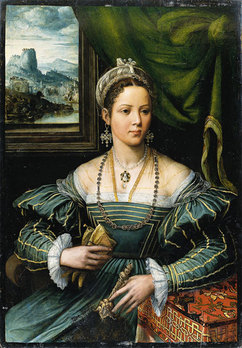Pedro Campaña on:
[Wikipedia]
[Google]
[Amazon]

 Pedro Campaña (1503–1586) was a
Pedro Campaña (1503–1586) was a
Web Gallery of Art: Biography of Pedro Campaña
{{DEFAULTSORT:Campana, Pedro 16th-century Flemish painters Painters from Seville 16th-century Spanish painters Spanish male painters 1503 births 1586 deaths

 Pedro Campaña (1503–1586) was a
Pedro Campaña (1503–1586) was a Flemish
Flemish (''Vlaams'') is a Low Franconian dialect cluster of the Dutch language. It is sometimes referred to as Flemish Dutch (), Belgian Dutch ( ), or Southern Dutch (). Flemish is native to Flanders, a historical region in northern Belgium; ...
painter of the Renaissance
The Renaissance ( , ) , from , with the same meanings. is a period in European history
The history of Europe is traditionally divided into four time periods: prehistoric Europe (prior to about 800 BC), classical antiquity (800 BC to AD ...
period, mainly active in Italy and Spain. His actual name was Pieter de Kempeneer, translated into French as Champaigne, and was also known as Peter van de Velde.
Biography
Born inBrussels
Brussels (french: Bruxelles or ; nl, Brussel ), officially the Brussels-Capital Region (All text and all but one graphic show the English name as Brussels-Capital Region.) (french: link=no, Région de Bruxelles-Capitale; nl, link=no, Bruss ...
, he trained there with Bernard Van Orley. His early life appears to have been spent in Italy, where he carefully studied the paintings of Raphael
Raffaello Sanzio da Urbino, better known as Raphael (; or ; March 28 or April 6, 1483April 6, 1520), was an Italian painter and architect of the High Renaissance. His work is admired for its clarity of form, ease of composition, and visual a ...
, and declared himself as his pupil. In 1530 he was at work at some scene-painting, representing a triumphal arch
A triumphal arch is a free-standing monumental structure in the shape of an archway with one or more arched passageways, often designed to span a road. In its simplest form a triumphal arch consists of two massive piers connected by an arch, cro ...
to be erected on the occasion of the coronation of Charles V, Holy Roman Emperor in Bologna
Bologna (, , ; egl, label=Emilian language, Emilian, Bulåggna ; lat, Bononia) is the capital and largest city of the Emilia-Romagna region in Northern Italy. It is the seventh most populous city in Italy with about 400,000 inhabitants and 1 ...
, and he then left for Spain, on the advice, it is said, of Cardinal Domenico Grimani
Domenico Grimani (19 February 1461 – 27 August 1523) was an Italian nobleman, theologian and cardinal. Like most noble churchman of his era Grimani was an ecclesiastical pluralist, holding numerous posts and benefices. Desiderius Erasmus d ...
, and spent the rest of his life in that country, only returning to Brussels about 1563 or 1565.
Between 1537 and 1562 he was associated with Luis de Vargas
Luis de Vargas (1502–1568) was a Spanish painter of the late-Renaissance period, active mainly in Seville. He traveled to Rome where he was influenced by Mannerist styles. He painted an altarpiece with multiple panels, including a ''Virgin and C ...
and the Italian sculptor Torregiano in establishing a school of painting in Seville
Seville (; es, Sevilla, ) is the capital and largest city of the Spanish autonomous community of Andalusia and the province of Seville. It is situated on the lower reaches of the River Guadalquivir, in the southwest of the Iberian Peninsula ...
, which eventually became the academy of the place; among the pupils educated in it was Morales
Morales is a Spanish surname. Notable people with the surname include:
* Alfredo Morales (born 1990), American footballer
* Alvaro Morales (disambiguation), several people
* Amado Morales (born 1947), Puerto Rican javelin thrower
* Bartolomé Mo ...
. He painted for the monastery of St. Mary of Grace, Church of Santa Cruz, in the city, an altar-piece representing the ''Descent from the Cross'' (1548), which is now in the cathedral, having been removed there when the church fell into ruins. There are other works by the same painter in Seville Cathedral
The Cathedral of Saint Mary of the See ( es, Catedral de Santa María de la Sede), better known as Seville Cathedral, is a Roman Catholic cathedral in Seville, Andalusia, Spain. It was registered in 1987 by UNESCO as a World Heritage Site, along ...
, especially two representing the ''Purification of the Virgin'' and the ''Resurrection'', the impressive main retable of Santa Ana, and others in various churches of the city, such as San Isidoro, San Pedro, Santa Catalina, and San Juan de la Palma. One of his last works was the restoration and repainting of a chapel belonging to Hernando de Jaen, an important resident of Seville. Murillo requested that he be buried near Campaña's picture, and his burial took place in the Church of Santa Cruz, close underneath the ''Descent from the Cross'', but the whole building was burned to the ground during the Napoleonic Wars
The Napoleonic Wars (1803–1815) were a series of major global conflicts pitting the French Empire and its allies, led by Napoleon I, against a fluctuating array of European states formed into various coalitions. It produced a period of Fren ...
, and the tomb perished.
Notes
References
* *''The Paintings of Francisco de Herrera, The Elder'', by John S. Thacher. The Art Bulletin (1937); page 327.External links
Web Gallery of Art: Biography of Pedro Campaña
{{DEFAULTSORT:Campana, Pedro 16th-century Flemish painters Painters from Seville 16th-century Spanish painters Spanish male painters 1503 births 1586 deaths